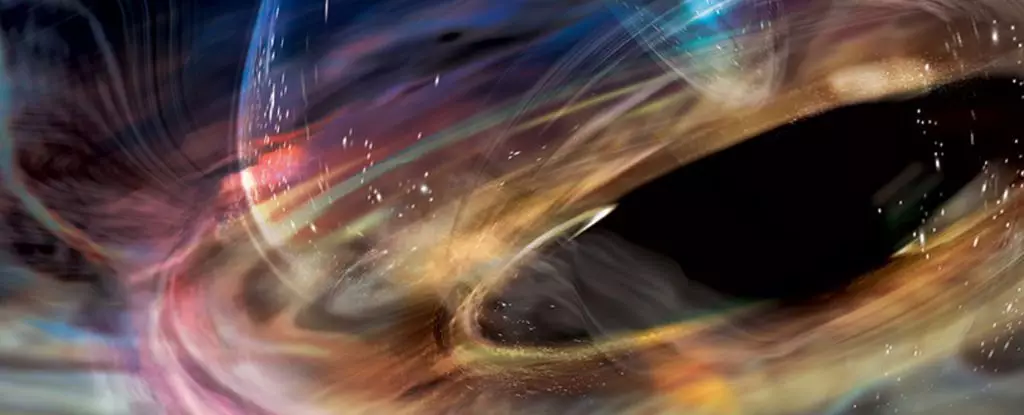Located a staggering 275 million light-years away from our galaxy, the supermassive black hole at the center of the distant galaxy 1ES 1927+654 has captured the attention of astronomers worldwide. This black hole has been at the heart of multiple enigmatic scenarios that challenge our understanding of cosmic phenomena. Recent research suggests that an orbiting white dwarf star is contributing to its bizarre behavior, presenting exciting new insights that could influence future studies of black holes and the extreme environments in their vicinity.
The universe is teeming with black holes, but 1ES 1927+654 is particularly intriguing due to its unpredictable behavior. Starry bodies like white dwarf stars, remnants of medium-sized stars, could play a critical role in understanding these anomalies. Researchers, led by physicist Megan Masterson from MIT, have posited that this white dwarf star is venturing very closely to the black hole’s event horizon—the point beyond which not even light can escape—raising stimulating questions about the dynamics between these astronomical entities.
Supermassive black holes, despite their name, do not produce light themselves; however, they are often surrounded by accretion disks composed of gas and dust. As matter spirals into a black hole, it heats up due to gravitational forces and friction, emitting light across various wavelengths. Changes in this light can offer tantalizing clues to theorize the black hole’s interactions with nearby celestial bodies. Notably, the black hole within 1ES 1927+654 was not considered unusual until a sudden plunge in its luminosity in 2018 was followed by an extraordinary resurgence—its brightness skyrocketed to nearly twenty times its prior levels.
This dramatic fluctuation has propelled researchers into deeper investigation, especially after the European Space Agency’s XMM-Newton space telescope unveiled a new layer of complexity in mid-2022 with X-ray data indicating that the black hole was exhibiting quasi-periodic oscillations in brightness. The consistent oscillations hinted at an unidentified object orbiting the black hole, possibly resulting in variations reminiscent of a metronome ticking unsteadily under the influence of an unseen hand.
Delving into the observations made, the critical question arose: What could account for such variability? To answer this, astronomers needed to examine the intrinsic characteristics of the light emitted, alongside the peculiar timing of its flickers. Erin Kara, another physicist at MIT, highlighted the significance of such rapid variability, signifying an object within an exceptionally close range to the black hole—likely within the grasp of its gravitational pull.
By modeling various scenarios, the researchers came to a compelling hypothesis: a dense white dwarf star is precariously spiraling toward the black hole. As this star advances deeper into the black hole’s feasting shadow, the intervals between its light emissions decrease. The analysis indicates that this white dwarf, with a mass approximately one-tenth that of our Sun, could be completing an orbit in a time frame alarmingly shrinking from eighteen to under seven minutes.
What’s fascinating is that this white dwarf star may not face imminent demise despite its precarious situation. Observations suggest that the black hole can siphon off its outer layers, but due to the star’s dense composition, it might withstand the onslaught. Employing complex models, astronomers propose the possibility of the white dwarf gaining sufficient momentum to escape the immediate gravitational influence of the black hole. In essence, it could retrogress to a safe distance, making the interaction less of a death sentence and more of a cosmic tango, a dance between gravitational extremes.
If the researchers’ predictions hold true, they could witness a gradual retreat in the star’s orbit as observable changes lengthen the oscillation periods of its X-ray emissions. This unfolding dynamic would not just be a victory for this academic endeavor, but a monumental stride in comprehending the oddities surrounding black holes and debunking previously held notions of their destructive nature.
As the universe continues to reveal its layered complexities, 1ES 1927+654 stands as a crucial testament to the unpredictable interactions between celestial entities. As noted by Masterson, the path ahead necessitates relentless observation; black holes never cease to educate those who are observant. The unfolding drama surrounding this system beckons astronomers to stay vigilant, for it holds the key to understanding one of the universe’s most formidable forces—black holes—and their influences in the cosmic theater.
The investigation of 1ES 1927+654 encourages both awe and curiosity about our universe, reaffirming the ideology that even centuries of research can lead to newfound discoveries and texts to be penned in the annals of astronomy. Observational science, driven by innovation and imagination, urges us to look closer and question deeper, setting the stage for future revelations that lie ahead.


Leave a Reply